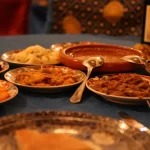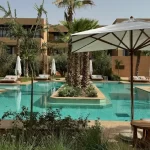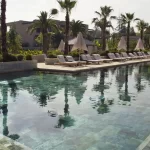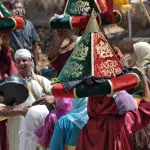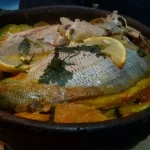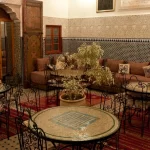Morocco’s Historical Sites: A Local’s Guide to UNESCO Heritage
Salmane Bougzime
September 28, 2025

Ever wondered what it feels like to step back through 1,200 years of history in a single journey?
As a tour guide who’s spent the last decade leading visitors through Morocco’s UNESCO treasures, I still remember my first overwhelmed tourists trying to decide between exploring Fes’s labyrinthine medina or spending more time at the majestic Ait-Ben-Haddou kasbah.
The truth is, Morocco’s historical sites are like chapters in an epic tale, each one revealing layers of Islamic, Berber, and French colonial heritage that have shaped this remarkable country.
From the intricate zellige tilework adorning ancient mosque walls to the weathered cedar doors that have welcomed traders for centuries, these landmarks hold stories waiting to be discovered.
Whether you have a week or just a few days, I’ll help you navigate the must-see historical wonders that make Morocco truly unforgettable.
Let’s explore how to make the most of your time among these architectural masterpieces that have earned their place on the world heritage stage.
UNESCO World Heritage Sites | Exploring Morocco’s Gems

When you visit Morocco’s UNESCO World Heritage Sites, you’ll find yourself walking through centuries of history, starting with the maze-like Medina of Fes, which earned its prestigious status in 1981.
You can explore five remarkable medieval cities, including the ochre-walled Medina of Marrakech and the fortified Ksar of Ait-Ben-Haddou, each showcasing distinct architectural styles from Morocco’s imperial past.
As you continue your journey through these protected sites, you’ll discover the grand Historic City of Meknes, known for its massive walls, and the pristine Medina of Tetouan, which perfectly captures the influence of Andalusian architecture in northern Morocco.
1. Medina of Fes (1981)

The majestic Medina of Fes, inscribed as a UNESCO World Heritage Site in 1981, stands as Morocco’s largest medieval city and a living testament to Islamic urban planning.
Within its defensive walls, you’ll discover the world’s oldest university, Al-Qarawiyyin, founded in 857 by Fatima al-Fihri, which helped establish Fes as a major intellectual center.
As you explore the medina’s 9,000 winding alleyways, you’ll encounter historic small hotels, traditional funduqs, and the famous leather tanneries where artisans still practice centuries-old techniques.
The city reached its peak during the 13th-14th centuries under the Almohad Dynasty, rivaling Cairo in size and influence.
Today, this remarkable cultural heritage site offers an authentic glimpse into medieval Islamic life, with its fountains, religious schools, and bustling souks remaining remarkably preserved.
2. Medina of Marrakech (1985)

Surrounded by imposing 2-meter-thick walls and rising 9 meters into the sky, Marrakech’s historic medina stands as a magnificent testament to 12th-century Almohad architecture and urban planning.
The city’s distinctive red clay walls have earned it the nickname “Red City,” creating a striking backdrop for your exploration.
You’ll begin your journey at the bustling Jamaa el-Fna square, where you’ll find vibrant food stalls and juice vendors.
The nearby Koutoubia mosque, with its impressive 77-meter minaret, dominates the skyline and showcases the architectural style that later influenced Seville’s Giralda.
As you venture deeper into the medina’s winding streets, you’ll discover countless craft shops and historical sites, including the Ben Youssef Madrasa, a 16th-century Islamic school featuring over 130 intricately decorated rooms.
3. Ksar of Ait-Ben-Haddou (1987)

Perched majestically at the foot of Morocco’s High Atlas Mountains, Ksar of Ait-Ben-Haddou stands as a remarkable example of southern Moroccan architecture, with its distinctive red earthen buildings rising dramatically from the desert landscape.
This UNESCO World Heritage site, first fortified in the 11th century, served as a crucial stop along caravan trading routes between the Sahara and Marrakech.
You’ll find that today’s structures, dating from the 17th century onward, were built using traditional methods of rammed earth and straw, following ancient architectural techniques.
While these materials make the fortified villages vulnerable to erosion, they’ve managed to preserve their authentic charm.
You can easily visit Ait Ben Haddou as a day trip from Marrakech or Ouarzazate, where you’ll recognize settings from famous films like Lawrence of Arabia and Game of Thrones.
Visitors can climb to the summit of the ancient Tizi n’Tichka pass at 2,200 meters elevation for breathtaking views of the Atlas Mountains and traditional Berber villages below.
4. Historic City of Meknes (1996)

Majestic Meknes, one of Morocco’s four imperial cities, stands as a testament to the ambitious vision of Sultan Moulay Ismail, who transformed this 11th-century military settlement into his grand capital during the 17th century.
You’ll discover the city’s impressive defensive walls surrounding a remarkable palatial complex that showcases the sultan’s architectural prowess.
At the heart of the historic city lies Place al-Hedim, where you can admire the magnificently decorated Bab al-Mansour gate, considered one of North Africa’s most beautiful entrances.
Don’t miss the Madrasa Bou Inania, a religious school adorned with intricate zellij tilework that reflects the city’s artistic heritage.
The legacy of Khanata bint Bakkar, who rose from the sultan’s harem to establish Morocco’s first organized health care system, adds a fascinating layer to Meknes’s rich history.
5. Medina of Tetouan (1997)

The white-washed buildings of Tetouan’s medina rise gracefully along northern Morocco’s Jebel Dersa mountainside, where Andalusian refugees created this remarkable city after fleeing Spain’s Reconquista.
You’ll discover a captivating blend of architecture within the medina’s 5km protective wall, which features seven distinct gates.
The strong Andalusian influence is evident not only in the buildings but also in the local Darija dialect, which carries more Spanish elements than other Moroccan regions.
As you explore the bustling markets, you’ll encounter mule carts loaded with fresh strawberries and vendors serving traditional Harira soup.
The medina remains authentically Moroccan while preserving its unique Andalusian heritage.
Whether you’re planning a day trip from Tangier or using Tetouan as a base to visit nearby Chefchaouen, this UNESCO World Heritage site offers an enriching cultural experience.
6. Archaeological Site of Volubilis (1997)

Standing as North Africa’s best-preserved Roman ruins, Volubilis sprawls across 42 hectares of fertile Moroccan countryside, where you’ll discover an ancient city that flourished from the 3rd century BC through multiple civilizations.
This remarkable archaeological site thrived under Roman rule, becoming a major olive-producing center at the empire’s edge.
You’ll find impressive triumphal arches, intricate mosaics, and well-preserved thermal baths that showcase the city’s rich history.
When the Islamic Idrisid dynasty made Volubilis their capital, they added another layer to its cultural significance.
After being abandoned for nearly a millennium, the historic site now stands as a UNESCO World Heritage monument, offering you glimpses into both Roman and Islamic periods.
You can easily visit Volubilis on a day trip from either Fes or Meknes.
7. Medina of Essaouira – Formerly Mogador (2001)

Nestled along Morocco’s Atlantic coast, Essaouira’s ancient medina captivates visitors with its distinctive blend of European military architecture and traditional Moroccan design.
This historic site showcases impressive fortifications designed by an international team of architects under King Mohammed III’s commission in the 18th century.
You’ll find Dutch-made cannons adorning the ramparts, which have recently gained fame as a filming location for popular shows like Game of Thrones.
As you explore the medina, you can discover remnants of the city’s Jewish heritage in the mellah and cemetery, a testament to its role in international trade.
Don’t miss the chance to experience the city’s vibrant cultural scene, where you’ll hear the enchanting sounds of Gnaoua music, a unique Moroccan tradition combining ritual poetry, music, and dance.
8. Portuguese City of Mazagan – El Jadida (2004)

Built by Portuguese colonizers in the early 16th century, Mazagan stands as one of Africa’s earliest European fortified settlements, earning its UNESCO World Heritage status in 2004.
The historic coastal city’s star-shaped fortress features a remarkable Portuguese cistern, where Gothic pillars create haunting reflections in collected rainwater below a circular opening.
After the Portuguese departed, the settlement was renamed El Jadida, meaning “The New,” and evolved into a vibrant center of commerce.
You’ll find a fascinating mix of cultural heritage here, with mosques, churches, and synagogues dotting the landscape.
Today, you can easily reach this historic gem from Casablanca and choose from several luxury resorts that offer a perfect base for exploring the fortress and surrounding attractions.
9. Rabat: Modern Capital and Historic City (2012)

While many Moroccan cities showcase either ancient medinas or modern developments, Rabat uniquely harmonizes both worlds as Morocco’s capital since 1912.
You’ll find much to see along the Atlantic Ocean, where 12th-century Almohad fortifications stand alongside elegant French colonial architecture.
The narrow streets of the old medina lead you through a living museum of Morocco’s heritage, while modern trams glide past historic sites in Morocco’s most forward-thinking city.
Don’t miss the majestic Dar al-Makhzen, built in 1864, which continues to serve as a royal palace today. The ancient Chellah ruins and stunning Kasbah des Oudayas offer glimpses into the city’s rich past.
You can easily reach Rabat by air or train, making it an accessible destination for exploring Morocco’s architectural evolution.
The Tentative UNESCO World Heritage Sites
When you explore Morocco’s tentative UNESCO World Heritage sites, you’ll discover remarkable locations like Moulay Idriss Zerhoun, an ancient holy city, and Taza with its magnificent Great Mosque dating back to the 12th century.
The list includes the historically significant Tinmal Mosque, built in 1153 as a spiritual center for the Almohad dynasty, alongside the ancient Phoenician-Roman ruins of Lixus and the archaeological treasure of El Gour.
These sites, all added to Morocco’s tentative list in 1995, represent crucial pieces of the nation’s rich cultural mosaic, spanning various periods from ancient Roman settlements to medieval Islamic architecture.
1. Moulay Idriss Zerhoun (1995)

Perched gracefully on the slopes of Jebel Zerhoune, the sacred town of Moulay Idriss Zerhoun stands as one of Morocco’s most venerated pilgrimage sites, housing the tomb of Idris I, the founder of Morocco’s first Islamic dynasty.
Founded in the 8th century, this remarkable town holds deep religious significance for Moroccans, with its centerpiece being the magnificent green-tiled mausoleum complex and mosque nestled within the heart of the Medina.
You’ll find numerous religious monuments throughout the town, reflecting its importance as a spiritual center.
What makes this location even more compelling is its proximity to the UNESCO-protected Volubilis Roman ruins, just 3km away.
The burial place of Moulay Idriss I, who introduced Islam to Morocco, continues to draw visitors seeking to explore both its spiritual significance and architectural beauty.
2. Taza and the Great Mosque (1995)

Between the rugged peaks of the Rif and Middle Atlas mountains lies the historic city of Taza, a strategic crossroads that flourished during Morocco’s 12th-century Almohad dynasty.
You’ll find this northern Moroccan city’s historical significance reflected in its impressive defensive structures, including ancient walls and bastions that protected this vital east-west route.
At the heart of Taza stands the Great Mosque, one of Morocco’s finest examples of Almohad architecture.
When you visit this architectural marvel, you’ll be amazed by its most striking feature – a massive chandelier weighing approximately 3 tonnes.
This remarkable lighting fixture, suspended within the mosque’s interior, serves as a testament to the sophisticated craftsmanship and engineering capabilities of the Almohad period, making the Great Mosque an essential stop on any historical tour of Morocco.
3. Tinmal Mosque (1995)

The magnificent Tinmel Mosque, constructed in 1156 in Morocco’s High Atlas Mountains, stands as one of the most significant examples of Almohad architecture and served as the inspiration for Marrakesh’s famous Koutoubia Mosque.
Nestled in a small Berber village, this historic site holds immense cultural significance as it was built to honor Ibn Tumart, the revered founder of the Almohad dynasty.
When you visit this remarkable monument, you’ll discover its strategic mountain location and architectural grandeur that have stood the test of time.
The mosque’s design elements, which later influenced the construction of the Koutoubia, showcase the sophisticated engineering and artistic capabilities of the Almohad period.
Today, it remains one of Morocco’s most important historical treasures, offering you a glimpse into the country’s rich architectural heritage.
The mosque’s impressive T-shaped floor plan spans 48 by 43 meters with nine longitudinal naves aligned perfectly with Mecca.
4. The City of Lixus (1995)

Moving from the mountain heights of Tinmal to Morocco’s Atlantic coast, ancient Lixus stands as one of the Mediterranean’s oldest cities.
You’ll find these remarkable ruins just outside Larache, where they showcase over 2,000 years of history as a coastal stronghold of Roman Mauritania.
As you explore the site, you’ll discover well-preserved Roman baths, impressive 4th-century walls, and intricate mosaic flooring.
The ancient temples and Christian church reflect the city’s diverse religious heritage, while the extensive complex for producing salted meat hints at its economic importance.
Occupied from the 8th century BCE until the 14th century CE, Lixus reveals five distinct phases of civilization: Phoenician, Punic, Mauretanian, Roman, and Islamic, making it an essential stop for anyone interested in Morocco’s rich archaeological heritage.
5. El Gour – Souk el Jemaa el Gour (1995)

Situated 30 kilometers southeast of Meknes, El Gour stands as a remarkable example of ancient Moroccan burial architecture, featuring a distinctive stepped pyramid design known as a Banzina.
This historic burial site, constructed between the 2nd and 4th centuries BCE, represents one of Morocco’s most intriguing archaeological treasures that you’ll want to explore.
The site’s most striking feature is its carefully arranged circular steps, built from precisely cut stone blocks that have endured centuries of exposure.
While historians believe El Gour was constructed to honor an important person, much of the site’s history remains shrouded in mystery due to limited research.
You’ll find that this ancient burial mound offers a unique glimpse into Morocco’s pre-Islamic burial practices, though access and visitor facilities may be limited.
6. Taforalt Cave (1995)

Deep within Morocco’s northern Oujda region, Taforalt Cave stands as a remarkable testament to human prehistory, offering you a fascinating glimpse into life during the Middle Paleolithic and Epipaleolithic periods.
Also known as “Grotte des Pigeons,” this prehistoric site near the village of Taforalt holds significant archaeological treasures that you’ll find captivating.
As you explore the cave, you’ll discover evidence of the Iberomaurusian lithic industry and an impressive necropolis containing remains of about one hundred Mechta-Afalou individuals, dating back approximately 20,000 years.
The cave’s layers reveal a rich collection of Paleolithic artifacts and materials that showcase early human activity in North Africa, making it one of Morocco’s most important prehistoric sites for understanding ancient human settlements and cultural development.
7. Talassemtane National Park (1998)

From the prehistoric depths of Taforalt Cave, we journey to the majestic heights of Talassemtane National Park, a natural wonder in Morocco’s northern Rif region that earned its place on UNESCO’s Tentative World Heritage list in 1998.
You’ll find this remarkable park near the charming city of Chefchaouen, where dramatic limestone formations create a stunning landscape of mountain peaks, gorges, caves, and towering cliffs.
As part of the ‘Transcontinental Biosphere Reserve of the Mediterranean,’ Talassemtane plays a crucial role in conservation efforts, particularly in protecting the endemic Moroccan fir and the endangered Atlas cedar tree.
The park’s ongoing reforestation initiatives focus on preserving these rare species, making it not just a testament to Morocco’s natural heritage but also a vital center for biodiversity conservation in North Africa.
8. The Area of the Dragon Tree Ajgal (1998)

The remarkable Dragon Tree Ajgal area, added to UNESCO’s Tentative World Heritage list in 1998, showcases one of Morocco’s most unique botanical treasures in the Anti-Atlas mountains.
You’ll find this extraordinary site nestled along the mountainsides of Jebel Imzi and Jebel Adad Medni, where isolated ecosystems have preserved the endemic Dracaena draco ajgal, a fascinating relative of the asparagus family.
The area’s pre-steppe environment isn’t typically full of tourists, which has helped protect its distinctive flora.
While exploring these remote sites, you’ll encounter the namesake Dragon Tree and the celebrated argan tree thriving in their natural habitat.
The region’s inaccessibility has created a pristine sanctuary where these rare species continue to flourish, making it an important destination for botanical enthusiasts and researchers alike.
9. Khnifiss Lagoon (1998)

Stretching across 60,000 hectares of Morocco’s pristine coastline, Khnifiss Lagoon stands as a natural wonder where desert dunes meet the Atlantic waters, creating one of North Africa’s most important ecological sanctuaries.
You’ll find this remarkable site just north of Western Sahara, where National Route 1 provides convenient access through the National Park.
As you explore the area, you’ll discover diverse habitats that contrast sharply with the surrounding desert environment.
The lagoon serves as a crucial stopover for migrating birds, making it an excellent spot for birdwatching enthusiasts.
While the natural features are stunning, the site also holds historical significance, with prehistoric archaeological remains offering glimpses into ancient human presence.
The dramatic landscape, where rolling sand dunes merge with the Atlantic coastline, creates an unforgettable scene that showcases Morocco’s natural heritage.
10. Dakhla National Park (1998)

Moving south along Morocco’s Atlantic coast, you’ll encounter another remarkable meeting point of desert and sea at Dakhla National Park, which earned its spot on UNESCO’s tentative World Heritage list in 1998.
This expansive park, encompassing the coastal city of Dakhla, offers you a unique glimpse of where the mighty Sahara Desert meets the Atlantic sea.
You’ll find the park’s arid landscape teeming with diverse animal and plant species adapted to desert life.
As a birdwatcher’s haven, it’s an ideal spot for observing various avian species in their natural habitat.
Along the coastline, you can spot colonies of monk seals, adding to the park’s ecological significance.
While located in the disputed territory of Western Sahara under Moroccan control, the park remains an important natural heritage site worth exploring.
11. Figuig Oasis (2011)

Located at Morocco’s easternmost edge, Figuig Oasis stands as a remarkable testament to human adaptation in the Sahara, where you’ll discover a mesmerizing blend of ancient architecture, prehistoric art, and verdant palm groves nestled against the Algerian border.
As you explore this historic oasis, you’ll encounter traditional earthen architecture that perfectly suits the desert climate, alongside an intricate network of irrigation channels that have sustained life here for centuries.
The site’s rich heritage includes fascinating prehistoric rock carvings, ancient ramparts, and sacred mausoleums dedicated to important historical figures.
You’ll be amazed by the thriving date palms and lush gardens that create a unique microclimate within the Ksour Range, offering a striking contrast to the surrounding desert landscape.
The oasis maintains its isolated charm while showcasing remarkable preservation of traditional desert life.
12. Casablanca (2013)

A bustling metropolis of architectural wonders, Casablanca showcases Morocco’s most impressive collection of 20th-century design, where you’ll discover an extraordinary fusion of Neo-Moorish, Neoclassical, and Art Deco styles throughout its modern city center.
As you explore this historic port town, you’ll find a fascinating blend of cultural influences that reflect its complex past.
From its early Berber settlements to Roman occupation, and later Portuguese bombardments, Casablanca has evolved into the largest city in the Maghreb.
During the French protectorate period, the city underwent major transformations, resulting in the stunning architectural landscape you see today.
The carefully planned city center, built entirely in the 20th century, stands as a testament to the harmonious meeting of North African, European, and American design sensibilities.
13. String of Oases at Tighmert, Pre-Saharan region of Wad Noun (2016)

Deep in Morocco’s pre-Saharan region, the magnificent String of Oases at Tighmert stretches 30 kilometers along the Wad Noun, serving as a living monument to medieval North African civilization.
Formerly known as No Lamta’s capital until the 16th century, this historic site lies about 200km south of Agadir and 12km southeast of Goulmim.
You’ll discover stunning wild palm groves dotted with impressive ksar architecture, dating back to the area’s prominence as a vital trans-Saharan trade hub.
The fortified villages, a good example of traditional pisé construction, remind visitors of El Hassan’s influence in the region, much like the iconic Hassan Tower and Mausoleum of Mohammed V in Rabat.
Throughout the oases, you’ll find archaeological remains and vibrant markets that continue the age-old trading tradition of this remarkable desert landscape.
14. The Historic Centre of Tétouan (2024)

While centuries-old Islamic architecture dominates Tétouan’s medina, you’ll find an intriguing blend of Spanish colonial influence throughout this historic center, which earned its place on UNESCO’s Tentative World Heritage list in 2024.
When you explore Tétouan, you’ll discover its unique dual character shaped by two distinct waves of settlement.
- The first came in the 15th century when Andalusian families established the medina, bringing their traditional Islamic architectural styles.
- The second transformation occurred in the early 20th century when Tétouan became the capital of Spain’s protectorate in Morocco.
You’ll notice this especially in the Ensanche district, where Spanish urban planners created a modern extension that mirrors the layout of 19th-century Spanish cities, making Tétouan a fascinating example of cultural fusion near the Strait of Gibraltar.
Final Words
When you’re planning your Moroccan adventure, you’ll find that these historical sites offer an unparalleled glimpse into the nation’s rich past.
From the winding streets of Fes’s medina to the dramatic mud-brick architecture of Ait-Ben-Haddou, each location tells its own compelling story.
Don’t miss the chance to explore these UNESCO treasures, where centuries of Islamic, Berber, and Mediterranean influences have created an extraordinary cultural tapestry that’s still vibrant today.
Ready to experience Morocco’s historic wonders? Join our Morocco Desert Tours and discover enchanting adventures from Marrakech, Fes, Tangier, and Casablanca.
Travel in comfort with our private car and driver service, ensuring a stress-free journey to every destination.
From seamless airport transfer services to unforgettable day trips from Marrakech, we’ve got your adventure covered.
Start your Moroccan journey today!
